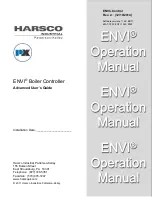Analog-to-Digital Converter (ADC12B12CV2) Block Description
MC9S12VRP Family Reference Manual Rev. 1.3
NXP Semiconductors
259
8.3.2.6
ATD Control Register 5 (ATDCTL5)
Writes to this register will abort current conversion sequence and start a new conversion sequence. If the
external trigger function is enabled (ETRIGE=1) an initial write to ATDCTL5 is required to allow starting
of a conversion sequence which will then occur on each trigger event. Start of conversion means the
beginning of the sampling phase.
Read: Anytime
Write: Anytime
Module Base + 0x0005
7
6
5
4
3
2
1
0
R
0
SC
SCAN
MULT
CD
CC
CB
CA
W
Reset
0
0
0
0
0
0
0
0
= Unimplemented or Reserved
Figure 8-8. ATD Control Register 5 (ATDCTL5)
Table 8-14. ATDCTL5 Field Descriptions
Field
Description
6
SC
Special Channel Conversion Bit
— If this bit is set, then special channel conversion can be selected using CD,
lists the coding.
0 Special channel conversions disabled
1 Special channel conversions enabled
5
SCAN
Continuous Conversion Sequence Mode
— This bit selects whether conversion sequences are performed
continuously or only once. If the external trigger function is enabled (ETRIGE=1) setting this bit has no effect,
thus the external trigger always starts a single conversion sequence.
0 Single conversion sequence
1 Continuous conversion sequences (scan mode)
4
MULT
Multi-Channel Sample Mode
— When MULT is 0, the ATD sequence controller samples only from the specified
analog input channel for an entire conversion sequence. The analog channel is selected by channel selection
code (control bits CD/CC/CB/CA located in ATDCTL5). When MULT is 1, the ATD sequence controller samples
across channels. The number of channels sampled is determined by the sequence length value (S8C, S4C, S2C,
S1C). The first analog channel examined is determined by channel selection code (CD, CC, CB, CA control bits);
subsequent channels sampled in the sequence are determined by incrementing the channel selection code or
wrapping around to AN0 (channel 0).
0 Sample only one channel
1 Sample across several channels
3–0
CD, CC,
CB, CA
Analog Input Channel Select Code
— These bits select the analog input channel(s).
lists the coding
used to select the various analog input channels.
In the case of single channel conversions (MULT=0), this selection code specifies the channel to be examined.
In the case of multiple channel conversions (MULT=1), this selection code specifies the first channel to be
examined in the conversion sequence. Subsequent channels are determined by incrementing the channel
selection code or wrapping around to AN0 (after converting the channel defined by the Wrap Around Channel
Select Bits WRAP3-0 in ATDCTL0). When starting with a channel number higher than the one defined by
WRAP3-0 the first wrap around will be AN11 to AN0.
Summary of Contents for MC9S12VRP64
Page 16: ...MC9S12VRP Family Reference Manual Rev 1 3 16 NXP Semiconductors ...
Page 46: ...Device Overview S12VRP Series MC9S12VRP Family Reference Manual Rev 1 3 46 NXP Semiconductors ...
Page 236: ...S12S Debug Module S12DBGV2 MC9S12VRP Family Reference Manual Rev 1 3 236 NXP Semiconductors ...
Page 244: ...Interrupt Module S12SINTV1 MC9S12VRP Family Reference Manual Rev 1 3 244 NXP Semiconductors ...
Page 358: ...Timer Module TIM16B2CV3 MC9S12VRP Family Reference Manual Rev 1 3 358 NXP Semiconductors ...
Page 436: ...Supply Voltage Sensor BATSV2 MC9S12VRP Family Reference Manual Rev 1 3 436 NXP Semiconductors ...
Page 528: ...NVM Electrical Parameters MC9S12VRP Family Reference Manual Rev 1 3 528 NXP Semiconductors ...
Page 530: ...Package Information MC9S12VRP Family Reference Manual Rev 1 3 530 NXP Semiconductors ...
Page 531: ...Package Information MC9S12VRP Family Reference Manual Rev 1 3 NXP Semiconductors 531 ...
Page 532: ...Package Information MC9S12VRP Family Reference Manual Rev 1 3 532 NXP Semiconductors ...


















